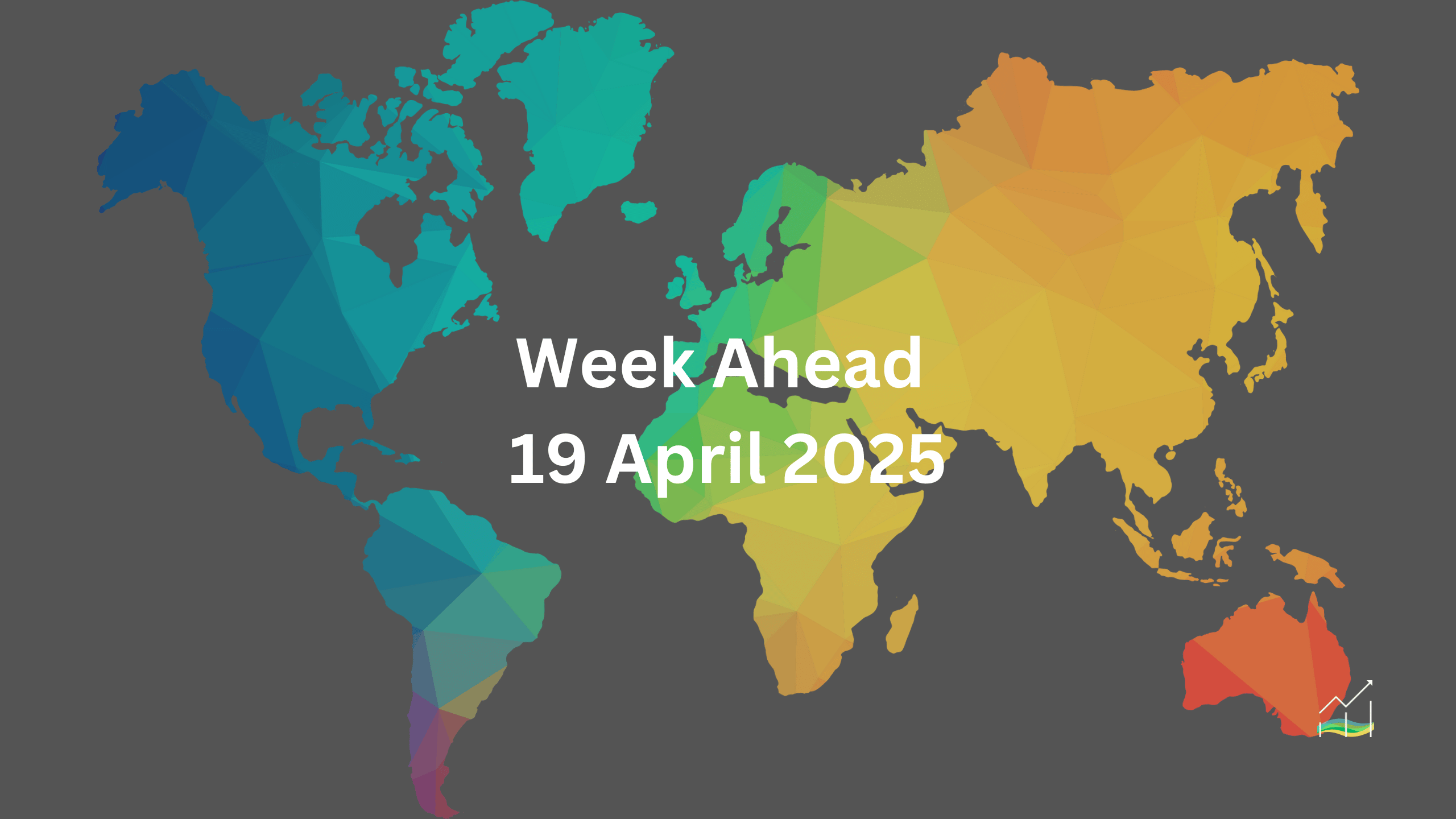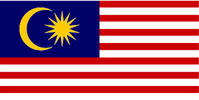19/04/2025 Week Ahead

Trade Calm Masks Fragile Sentiment Ahead of IMF Meetings
Key Takeaways:
- US tariff uncertainty continues, despite no major new measures last week.
- New shipping fees targeting foreign—especially Chinese—vessels to begin in October.
- Auto tariff delay possible, but long-term trade risks remain.
- Light economic calendar this week, with focus on US-Japan trade talks and IMF/World Bank spring meetings.
- Markets fragile as geopolitical risk lingers.
Capital markets stabilised somewhat last week after the prior week’s volatility, but uncertainty out of Washington continues to cloud the outlook. While the US did not extend tariffs broadly—apart from duties on Mexican tomatoes—it opened new investigations likely to result in future trade restrictions. President Trump signalled the potential delay of the upcoming 25% auto tariffs, set to begin early next month. Additionally, the administration announced a new policy: starting in October, foreign-owned vessels—especially those from China—will face a per-tonnage fee, increasing annually for the next three years.
This fragile stability lacks solid footing. The week ahead offers limited high-impact data, with only Japan’s preliminary April PMIs and Tokyo CPI standing out. However, two non-data events deserve close attention. First, US-Japan trade negotiations are set to enter a more intense phase, with Treasury Secretary Bessent meeting Japanese Finance Minister Kato. The tariff gap between the two countries is minimal, and Japan’s current policy stance does not suggest an intentional effort to weaken the yen. In fact, Japan hiked rates while others were easing, and last year spent around $100 billion to support its currency. Both sides are motivated to strike a deal, which could lift risk sentiment if progress is announced.
Second, the IMF and World Bank hold their spring meetings—a potential platform for the US administration to signal a shift in its global economic engagement. Recent rhetoric and policy papers like Project 2025 suggest a reduced appetite for multilateral cooperation, especially with institutions promoting environmental, diversity, or inclusion objectives. While a formal withdrawal is unlikely without Congressional support, reduced funding and participation could still shift the tone significantly, and investors should take the signals seriously.
United States of America
Overview
Sentiment toward the US continues to deteriorate as trade pressures and domestic policy shifts take a toll on investor confidence. Despite a temporary postponement of reciprocal tariffs, the average US tariff rate has surged to 14.5%—the highest level since 1938, up sharply from 2.5% at the start of the year. This sharp increase reflects a broader trend of escalating protectionism, which is beginning to weigh on international sentiment. At the same time, domestic disruptions are emerging from the labor market. Federal layoffs and restrictive immigration policies are expected to generate ripple effects, even if they have yet to show up clearly in the data.
From a valuation standpoint, the US remains a challenging proposition. Dollar-based assets—both the currency and equities—are widely viewed as overvalued. The flood of European capital into US equities in 2024, once seen as bullish, may have marked a cyclical top. These factors suggest that diversification away from US exposure is now not only ideological but also practical.
Economic Drivers
- Highest average tariff rate since 1938, now at 14.5%.
- Labor market disruptions from federal layoffs and reduced immigration.
- Growing perception that US equities and the dollar are overvalued.
- European buying of US stocks in 2024 potentially signalled a market top.
- Broader shift in sentiment away from US assets.
Data and Events
- April 22–26 – Durable Goods Orders (March)
- April 22–26 – Regional Fed Surveys (April)
- April 23 – S&P Global Preliminary PMIs (April)
- April 24 – Fed Beige Book
- April 25 – Weekly Initial Jobless Claims (week of April 20)
- April 30 – Advance Estimate for Q1 GDP
Price Action
- Dollar Index remains within April 11 range (~99.00–100.75).
- Resistance seen near 100.30; price closed near weekly lows.
- Bias remains bearish; DXY may be forming a top rather than a base.
- Historical analog: A 12.2% drop from September 2022 peak suggests possible move below 97.00 in coming weeks.
Key Points:
- Tariff rate surge reflects the most protectionist stance since the 1930s.
- Labor market distortions are growing but not yet fully visible in data.
- DXY risks another leg lower; bearish technical setup resembles 2022 peak.
- Q1 GDP estimates vary sharply—Atlanta Fed projects contraction, consensus expects mild growth.
- Broader reallocation away from US assets is gaining traction.
Australia
Overview
The Australian dollar has increasingly taken on the role of a risk-sensitive currency, now showing stronger correlation to global equity movements than the Canadian dollar. Over the past 30 sessions, the rolling 30-day correlation between AUD/USD and the S&P 500 stands slightly above 0.65—down from last year’s high of 0.75 but still meaningful. Notably, this correlation was inverted during the final two months of 2024. Meanwhile, AUD's correlation with gold reached a 10-month high earlier this month near 0.70 and currently remains firm around 0.60, reinforcing its sensitivity to broader risk and commodity trends.
Strategically, Australia faces a growing policy dilemma. While firmly embedded in the US security alliance, its economy remains deeply tied to China—its largest trading partner by far. Reports suggesting that Washington may use future bilateral trade negotiations to pressure allies into reducing economic ties with China bring this tension into sharper focus. Australia will likely come under increased scrutiny as it tries to balance security commitments with economic pragmatism.
Economic Drivers
- AUD’s correlation with the S&P 500 exceeds 0.65, indicating stronger risk-on behaviour.
- Correlation with gold prices remains high (~0.60), reinforcing commodity linkages.
- Rising geopolitical pressure from the US to reduce trade with China poses a strategic dilemma.
- Australia's balancing act between its US alliance and dependence on Chinese demand is increasingly strained.
Data and Events
- April 24 – S&P Global Preliminary PMIs (April)
Price Action
- AUD/USD ended a seven-day rally ahead of the weekend.
- Price rebounded strongly from the April 9 low (~$0.5915) to test resistance near $0.6400.
- The $0.6400 level continues to cap upside; key support lies at $0.6325–0.6335.
- A break below support could extend losses toward $0.6250–0.6280, particularly if momentum positions are unwound.
Key Points:
- AUD is behaving more like a global risk proxy than in previous months.
- Geopolitical pressure from the US on China trade could complicate Australia’s external position.
- Preliminary April PMI will offer an early read on Q2 momentum.
- Technical resistance remains firm at $0.6400; watch for downside momentum if support breaks.
Canada
Overview
The Canadian dollar is showing renewed sensitivity to broader macro themes, with correlations pointing toward a nuanced shift in behaviour. On a rolling 30-day basis, the correlation between CAD and the Dollar Index has climbed to 0.60—toward the upper end of its recent range. Despite some divergence in recent sessions, CAD still exhibits a risk-off profile, with its correlation to the S&P 500 (around 0.40) almost double its correlation to crude oil. Notably, CAD’s correlation with gold has risen to near 0.60, the highest level so far this year, signalling an evolving set of drivers influencing price action.
From a domestic perspective, consumer dynamics are being closely watched. While the recent sales tax holiday has distorted headline retail data, there are growing anecdotal signs of pressure on discretionary consumption. A reported boycott of US brands and a steep drop in outbound Canadian holiday bookings could signal a shift in household behaviour—especially if these trends start surfacing in official data releases.
Economic Drivers
- CAD’s 30-day correlation with the Dollar Index sits near 0.60, signalling tighter USD linkages.
- Risk-off bias persists: correlation with S&P 500 (~0.40) is nearly double that of crude oil.
- Rising gold correlation (near 0.60) points to alternative macro influences on CAD.
- Domestic sentiment appears fragile, with anecdotal signs of consumer fatigue and boycott activity.
Data and Events
- April 25 – February Retail Sales
Price Action
- USD/CAD touched a five-month low slightly below CAD1.3830 last week.
- Momentum stalled despite lower highs in the past three sessions.
- A push toward CAD1.3800 remains possible; this may act as near-term support.
- A sustained break below CAD1.3800 could target CAD1.3730 next.
Key Points:
- CAD correlations are shifting: gold and the USD now playing larger roles.
- Domestic consumption trends bear watching amid signs of economic fatigue.
- February retail sales could offer a clearer view after two distorted months.
- Price action suggests downside pressure on USD/CAD is not exhausted.
China
Overview
Beijing has maintained broad stability in the yuan, but subtle shifts suggest it is now tolerating slightly more exchange rate volatility. Given the global environment—marked by heightened uncertainty and increased capital market volatility—this adjustment appears calculated and prudent. Authorities seem content with their current strategy, at least for now, as the broader decline in the US dollar has eased immediate pressures. Should dollar strength re-emerge, China may reassess, but for the time being, it gains both time and space by staying the course.
The strategic signal is also visible in the People's Bank of China's daily dollar fixing. The average daily change has increased from just 0.01% earlier this year to more than 0.05% recently—a subtle but telling shift. This flexibility indicates a calibrated adjustment by the PBOC to reflect global pressures while preserving credibility. Importantly, the assumption that the dollar would strengthen on renewed trade tensions has so far not materialised. Since President Trump’s second inauguration, the greenback has declined against all G10 currencies, with more than half registering gains over 9%.
Economic Drivers
- PBOC appears to be allowing greater yuan flexibility amid global volatility.
- Increased volatility in the fixing rate suggests a more responsive stance.
- Weakening US dollar reduces pressure on China to aggressively defend the yuan.
- Beijing continues to prioritise exchange rate stability while managing trade tensions in the background.
Data and Events
- April 22 – One-Year and Five-Year Loan Prime Rate Fixing
Price Action
- Average daily change in PBOC dollar fixing has risen fivefold in recent weeks (~0.05% vs ~0.01% earlier in the year).
- Yuan stability remains intact, but with a clear shift toward more frequent adjustments.
- Broader USD weakness has reduced market tension around the yuan’s valuation.
- The CNY has appreciated alongside other G10 currencies since January.
Key Points:
- China is subtly recalibrating its FX policy to allow more flexibility without surrendering control.
- The increased range in daily fixings points to a strategic adjustment, not a policy shift.
- The current environment buys China time to manage domestic priorities before adjusting its FX stance further.
- Dollar weakness has removed immediate urgency from PBOC intervention efforts.
Europe
Overview
The euro continues to attract flows as investors reassess the relative risks between the US and Europe. While the US still offers a yield premium over the euro area, concerns about policy stability, geopolitical positioning, and even emergency liquidity access—such as swap line availability—have begun to erode the dollar's perceived safety premium. In contrast, the euro benefits from the depth of European capital markets and a more stable policy trajectory, positioning it as a credible alternative. As the US rebrands its economic strategy, the euro increasingly plays the role of a steady counterbalance.
The ECB cut its deposit rate to 2.25% last week, marking a notable policy shift. However, this week's economic data is unlikely to influence the outcome of the next meeting on June 5. Instead, focus will be on gauging the underlying resilience of the region’s economy. Industrial production figures highlight divergent growth across major economies. Germany and Italy contracted sharply in March, while France and Spain posted modest gains. The aggregate eurozone figure (+1.1%) suggests robust growth elsewhere—likely in smaller economies such as Ireland and Belgium, which are tightly integrated with US pharmaceutical and tech supply chains.
Auto sector data could provide further insight into consumer and industrial trends. New car registrations fell year-on-year in January and February, and if March figures follow suit, it may reinforce concerns about underlying demand. However, the euro's recent recovery, soft oil prices, and front-loaded import activity ahead of US auto tariffs may be temporarily obscuring structural weakness.
Economic Drivers
- Euro benefits from broader distrust in US fiscal and geopolitical direction.
- ECB rate cut to 2.25% marks a new phase of accommodation.
- Industrial output diverges across core economies; aggregate strength may be misleading.
- Front-loading of auto trade ahead of US tariffs may be masking demand softness.
- Eurozone capital markets offer diversification amid global uncertainty.
Data and Events
- April 22 – February Trade Balance
- April 23 – March New Car Registrations
- April 24 – March Construction Output
- April 24 – S&P Global Preliminary PMIs (April)
Price Action
- EUR/USD consolidated within April 11 range (~$1.1190–$1.1475).
- Price action suggests bullish consolidation, not exhaustion.
- Brief dip below $1.1275 tested 2023 highs and key retracement levels.
- Next resistance band lies between $1.1500 and $1.1700.
Key Points:
- Euro acting as a relative safe-haven amid US uncertainty.
- ECB policy easing contrasts with Fed ambiguity, but market focus is on structural fundamentals.
- Data this week unlikely to alter June rate expectations but may reveal underlying weaknesses.
- EUR/USD remains technically firm; bullish breakout possible if resistance is cleared.
Japan
Overview
The swaps market has sharply downgraded expectations for further Bank of Japan rate hikes this year. After the BOJ raised rates in January, another move was fully priced in through March. Now, the probability of another hike in 2025 is barely above 50%. This shift reflects a broader recalibration of Japan's monetary outlook amid subdued inflation and cautious forward guidance. Meanwhile, the correlation between USD/JPY and US 10-year yields has collapsed to below 0.30—its lowest in nearly a year—after peaking above 0.70 just weeks ago. However, the correlation with the US 2-year yield remains strong, hovering near 0.70, underscoring short-term rate differentials as the key driver.
On the data front, Tokyo’s April CPI at the end of the week will be the key focus. Government subsidies continue to distort the headline figures, but inflation pressures—particularly in processed food—appear to be firming. March CPI came in at 2.9%, while core CPI (ex-food) ticked up to 2.4%. A year ago, both readings were nearly a full percentage point lower. While the preliminary PMI and tertiary industry index are scheduled earlier in the week, these are unlikely to move markets.
Politically, attention turns to bilateral trade talks with the US, where foreign exchange is expected to feature prominently. Last year, Japan spent roughly $100 billion to support the yen, and US officials are reportedly eager for a quick resolution. With the dollar retreating sharply against the yen, the outcome of these talks could shape the near-term FX narrative.
Economic Drivers
- BOJ hike expectations have been repriced sharply lower; now only ~50% chance of another move in 2025.
- Correlation between USD/JPY and US 10-year yield has collapsed (<0.30); 2-year yield correlation remains elevated (~0.70).
- Japan’s inflation trend is ticking higher despite government subsidies.
- FX likely to be a central topic in US-Japan trade talks as the yen strengthens.
Data and Events
- April 23 – S&P Global Preliminary PMIs (April)
- April 23 – February Tertiary Industry Index
- April 26 – April Tokyo CPI
Price Action
- USD/JPY broke to new yearly lows near JPY141.60 last week.
- Key support zones lie at JPY140.00 and JPY139.60 (2024 low).
- Deeper retracement could target JPY139.25 (38.2% of post-Covid rally).
- 200-day moving average sits just below JPY138.00 and continues to rise.
Key Points:
- Market pricing for BOJ hikes has faded significantly; macro narrative has shifted.
- USD/JPY now tracks short-end rates more closely than long-term yields.
- Tokyo CPI will test the trend in core inflation amid noisy base effects.
- FX policy will be closely watched as US-Japan trade talks resume.
United Kingdom
Overview
Sterling's behaviour in cross-asset terms is shifting, with correlations across key pairs diverging from Q1 patterns. The 30-day correlation between GBP and EUR has fallen steadily since peaking near 0.90 in early April, now sitting below 0.70—the lowest since last November. At the same time, EUR/CHF correlations have risen above 0.85, overtaking EUR/GBP for the first time this year. Sterling’s inverse correlation with the Dollar Index has also moderated, declining from -0.90 in early April to slightly stronger than -0.75. These shifts suggest sterling is becoming more independently driven by domestic factors, particularly economic data and monetary policy expectations.
This week, markets will assess the UK’s preliminary April PMIs and March retail sales. The services sector has held up reasonably well, with last month’s PMI at 52.5, the highest since August 2023. Manufacturing remains deeply in contraction territory, at 44.9 in March. Retail sales data due at week’s end will test the resilience of consumer spending. January and February saw a marked rebound with gains of 1.4% and 1.0% respectively—the strongest two-month stretch since early 2021. However, this comes after four straight months of contraction in late 2024. Retail sales in the UK are measured by volume, not value, making them a more accurate read of underlying demand.
Economic Drivers
- GBP-EUR correlation has weakened notably, signalling reduced alignment with eurozone dynamics.
- Inverse DXY correlation also softening, pointing to more domestic data sensitivity.
- Services sector showing signs of momentum; manufacturing remains a drag.
- Retail consumption rebounded in early 2025 after months of contraction in late 2024.
Data and Events
- April 23 – S&P Global Preliminary PMIs (April)
- April 26 – March Retail Sales
Price Action
- GBP/USD is on a nine-day rally—the longest since July 2020—gaining ~4.5%.
- Price reached near $1.3300; next major resistance sits at $1.3435 (2024 high).
- Initial support at $1.3200; a break of $1.3150 could indicate a corrective phase.
- Momentum remains strong, with no immediate sign of exhaustion.
Key Points:
- Sterling is trading with increasing independence from eurozone and dollar trends.
- Retail and services data this week will be key to validating GBP strength.
- Nine-day rally leaves sterling technically overextended, but upside bias persists.
- Watch $1.3435 as the next major resistance; correction risks only materialise below $1.3150.
© 2025 SKONE Enterprise (003319453-V). All rights reserved.
The content on this site is for informational purposes only and does not constitute financial advice.


